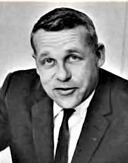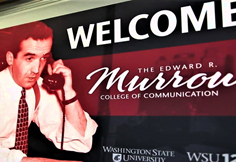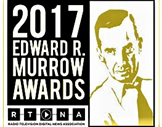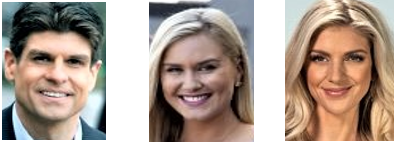 Washington State University (WSU) is a premier educational training ground for broadcasting. And it provides top drawer proficiency in other communication fields.
Washington State University (WSU) is a premier educational training ground for broadcasting. And it provides top drawer proficiency in other communication fields.
Previously discussed was the once-popular trend toward 90-day ticket punch schools for radio jobs in the 1950s and ‘60s. (See A Ticket to Broadcasting ). But you only have to look to the Palouse country of Eastern Washington to find a bigger success story.
It’s called the Edward R. Murrow College of Communication. And since the 1940s it’s produced perhaps the largest cumulative list of successful broadcasters – and other communications specialists – of any Pacific Northwest institution.
That’s pretty lofty standing for Washington State University’s communications program. But if you stick with this posting to the end, you’ll see a pretty impressive roster of WAZZU-trained professionals.

Without question, Ed Murrow was instrumental in starting that cascading success. (Some people think he actually gets too much credit.) After moving with his family from North Carolina at age 5, he grew up on Samish Bay in northwest Washington. In 1926 he enrolled in what became Washington State College. Murrow was later declared probably the college’s most famous and influential graduate after a remarkable broadcast journalism career. In 25 years at CBS, he became perhaps America’s most daring war correspondent, his tenacious and incisive journalist skills leading to the public downfall of communist fear monger Senator Joseph McCarthy in the early 1950s.

While Murrow was attending WSC, the college developed what was reported to be the country’s first college course in broadcasting. For over 30 years broadcast classes were part of the Speech Department and journalism taught in the English Department. In 1959 WSC became Washington State University, and five years later broadcasting and journalism were merged in the Liberal Arts College’s new Department of Communications. Certainly, Murrow’s impact spiked generations of success.


WSU’s pioneering efforts gained significant traction because of the progressive talents of Robert Mott. He’d joined the faculty in 1956 and later served as professor and department chair and manager of radio-TV services. During Mott’s 12 years in Pullman (1956 to 1968), he propelled WSU’s communication program to a model for hands-on skills development toward broadcast and broadcast-journalism careers.
Mott, who died at 98 in 2019, commanded legendary respect from legions of former students. He’d been a World War II paratrooper and was a survivor of Europe’s bloody Battle of the Bulge. His classroom demeanor was credited for shaping a brand of discipline and attention to detail that marked the later broadcast news careers of most of his students. In 1968 he became head of National Educational Radio in Washington D.C. and co-founded National Public Radio.
 WSC, one of the country’s first Land Grant institutions (1890), was a trail blazer in radio’s early days, establishing KFAE in 1922 (which changed to KWSC in 1925.) In 1926 the college’s speech dept. started a radio “performance” class where students were to prepare talks, skits, plays and similar material for airing on KWSC.
WSC, one of the country’s first Land Grant institutions (1890), was a trail blazer in radio’s early days, establishing KFAE in 1922 (which changed to KWSC in 1925.) In 1926 the college’s speech dept. started a radio “performance” class where students were to prepare talks, skits, plays and similar material for airing on KWSC.
Murrow was among the first students in that class, which continued into, and beyond, the post-WW II years, crediting the college and KWSC for providing students an actual on-air training platform as part of the curriculum. Before and after the call letter change to KWSU – and the addition of KWSU-TV – the college earned national acclaim as a leader in producing entertainment and documentary programs for public broadcast stations all over the country. Currently other campus radio stations include KZUU FM, with a first air date of 1979, and a format of alternative pop, excluding top-40. Student jocks at KUGR, traditionally known as “Cougar” radio, run sports and play music, including top-40 hits. KUGR was founded in 1954, back then the station was wired to every building on campus, but today it’s on cable and streams online.
It’s estimated that over the years more than 1,000 students got their first microphone or on-camera experiences at the Pullman campus., many advancing to on-air programming, production, news and eventual management positions in the growing broadcasting business, or related fields.
Murrow did a few return visits to the WSU campus before his lung cancer death in 1965. In 1952 he narrated a university promotional film “This is WSC.” which was redone by Art Gilmore, another famous alum, in 1962. Below are two audio clips.

Welcome to WSU film — Audio of Ed Murrow and Art Gilmore (Running time :58)
 The Murrow College of Communications ranked among the country’s top 25 journalism schools in a 2012 NewsPro Magazine survey. The Murrow school promotes itself as the state’s only comprehensive broadcast program and the Northwest’s leading curricula in professional skill building and theory in all six fields: advertising, broadcasting, communication, communication studies, journalism and public relations. Its broadcast journalism sequence has been rated in the nation’s top five by the Radio and Television Digital News Association. Since 1971 the association has annually bestowed its Edward R. Murrow Awards, among broadcast journalism’s most coveted recognition honors.
The Murrow College of Communications ranked among the country’s top 25 journalism schools in a 2012 NewsPro Magazine survey. The Murrow school promotes itself as the state’s only comprehensive broadcast program and the Northwest’s leading curricula in professional skill building and theory in all six fields: advertising, broadcasting, communication, communication studies, journalism and public relations. Its broadcast journalism sequence has been rated in the nation’s top five by the Radio and Television Digital News Association. Since 1971 the association has annually bestowed its Edward R. Murrow Awards, among broadcast journalism’s most coveted recognition honors.
WSU also operates Northwest Public Radio, a 16-station regional network reaching up to 3.6 million people in Washington, Oregon and British Columbia, along with two PBS television stations.
Looking back at those early days, Murrow’s CBS network fame was soon joined by other WSU comm school grads who also gained national distinction. In addition to Gilmore (national radio-TV announcer and actor), there was Keith Jackson (network sports play-by-play) J. Elroy McCaw (multiple-station broadcast owner), Barry Serafin (national news correspondent) and Gary Larson (nationally syndicated cartoonist). Two others, perhaps lesser known, were Charlotte Friel and Kay Wight, both of whom became CBS network vice presidents.

 Below is a fast and unofficial list of some of the WSU Murrow College alums, spanning more than 80 years. You’ll likely recognize many of the names who scored broadcasting success in the Puget Sound area, or as reporters, editors or publishers. Others have become film and television writers/producers, private and public communication advisors and corporate, non-profit or other business community executives.
Below is a fast and unofficial list of some of the WSU Murrow College alums, spanning more than 80 years. You’ll likely recognize many of the names who scored broadcasting success in the Puget Sound area, or as reporters, editors or publishers. Others have become film and television writers/producers, private and public communication advisors and corporate, non-profit or other business community executives.
How many of the following Palouse-trained folks do you recognize?
Edward R. Murrow, J. Elroy McCaw, Art Gilmore, John Jarstad, Richard Ross, James R. Warren, Ross Woodward, LeRoy Desilet, John R. DiMeo, Roberta Ulrich, Ronald Forsell, John Stenkamp, Jay Rockey, Haines Fay, Charlotte Friel, John Knievel, Al Wallace, Charles Herring,
Howard Shuman, Ted Bryant, Jay Ward Giesa, Keith Jackson, Art McDonald, Gene Wike, Robert Lee Hardwick, Harold L. “Frosty” Fowler, Bill Brubaker, John Sandifer, Kay Wight, Tom Hunt, Art Eckman, Ronald King, Barry Serafin, Mike James, Ken Bertrand, Gary Justice, Steve Montgomery, Ron Carter, Jerry Isenhart, Tod Neuenshwander, Lan Archer, Don Pitzer, John E. Davis, Ted Warren, Pat Scott, Jeff Rounce, John Boril, Brooks Burford, Gary Larson, Bruce Amundson. Enrique Cerna, David Wike, Peter Van Sant, Lou Gellos, John Chelminiak, Tony Miner, Bryan Lowe, Lynn Espinoza, Marilyn Hawkins, Tim Pavish, Tracy Barry, Frank Shiers, Steve Wilson, Bill Swartz, Kathi Goertzen, Keith Shipman, Jeff Burnside, Dick Warsinske, Jeff Dubois, Dennis Kelly, Kathy Brock, Kerry Brock, Rod Simons, Mike Shepard, Molly Schotzko, Chris Daniels, Maura Gallucci, Brian McMillan, Carolyn Douglas, Jan Kuwahara, Bill Wixey, Jim Moore, Manda Factor, Lauri Jordana, Lorie Dankers, Margo Myers, Mark Wright, Greg Copeland, Denise Guerrero, Mary Nam, Ali Bradley, Curtis Wilson, Michelle Ludtka, Chris Cashman, Nicole Mirante-Matthews, Nick Allard, Jacqueline Brackett, Tony Black, Daniel Liberator, Lisa Van Cise, Cindy Brunson, Veronica Miracle, Andy Hurst, Jenna Luthman, Trevor VanDyke, Ana Cabrena, Steve McCarron, Chris Mulick, Sherry Nebel, Abby Acone, Paris Jackson, Kelly Koopmans, Holly Menino, Greg Witter, Sarah Reyes, Herman Meier, Megan Garrity, Katie Barker, Sean Quinton, Taylor Van Cise, Kyle Brown, Jay Hamilton, Keith Shipman, Neil Stover, Jamerika Haynes, Josh Munson, Derek Austin, Curtis Calhoun, Ben Creighton, Brenna Kelly . . . And undoubtedly many more . . .
Yesterday to today, WAZZU alums made their marks in Puget Sound TV news




Thanks for assistance from Bill Brubaker, the book Washington State On The Air by Burt Harrison
and the WSU Murrow College of Communications Alumni Association.
Ron DeHart, not a WSU alum, was a short-term student at the Univ. of Washington School of
Communications (1966), a broadcast grad (AFRTS) of DOD’s Defense Information School (1967) and a 1974 Communications graduate of the University of Minnesota.

Great piece. Proud to be a Murrow grad.